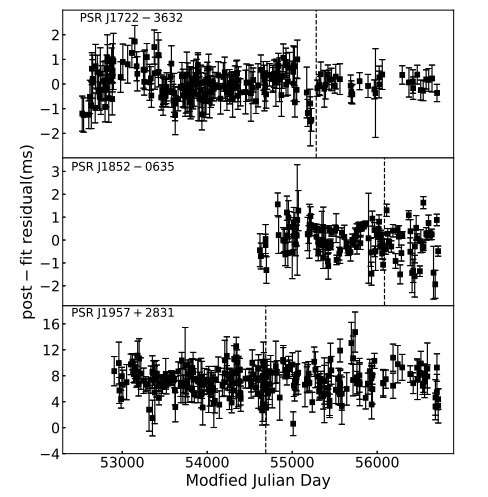Timing residuals of PSRs J1722−3632, J1852−0635 and J1957+2831 after fitting for all glitch parameters. The vertical black dashed line in each panel indicates the glitch epoch. Credit: Dang et al., 2020.
Astronomers from China and Australia have observed almost 90 pulsars with the Nanshan Radio Telescope in order to investigate their properties. Using the timing analysis method, the researchers determined positions, proper motions and rotation parameters of dozens of pulsars from the sample, and also detected glitches in three sources. The study was published May 5 on the arXiv pre-print server.
Pulsars are highly magnetized rotating neutron stars that emit beams of electromagnetic radiation. Astronomers employ the so-called pulsar timing technique to determine positions and proper motions of pulsars to test the general theory of relativity, and also to detect gravitational waves.
A team of researchers led by Shijun Dang of Xinjiang Astronomical Observatory (XAO), China, have employed this method to analyze observational data of 87 pulsars. The data were obtained by XAO's Nanshan 25-m Radio Telescope between July 2002 and March 2014.
"We have presented a timing analysis of 87 pulsars based on 12 years of observations using the Nanshan radio telescope at Xinjiang Astronomical Observatory," the paper reads.
The scientists managed to determine positions and proper motions for 48 pulsars. It was noted that out of these 48 pulsars, 24 received improved positions over values reported by previous studies. Moreover, the study provided improved proper motions for 21 pulsars, and in nine cases, the proper motions were determined for the first time.
Furthermore, the research obtained rotational parameters for the pulsars in the studied sample. For 36 pulsars, the new results have smaller uncertainties than previously published values.
The study provided transverse velocities of 48 pulsars. The astronomers emphasized that although the uncertainties of the new results are rather large, they are consistent with the data available in the literature.
Besides determining properties of the studied sources, the observations also detected glitches in three pulsars, namely: PSR J1722−3632, PSR J1852−0635 and PSR J1957+2831. These pulsars turned out to have relatively large characteristic ages for glitching pulsars, at a level of about 1.4, 0.6 and 1.6 million years, respectively.
In the case of PSR J1722−3632 and PSR J1852−0635, the glitches were found to be relatively large and post-glitch recoveries were observed, usually seen after large glitches. The astronomers noted that such recoveries can be explained by the so-called "vortex creep" model in which the rotation of the superfluid interior and the crust return to equilibrium after a glitch.
In general, glitches are observed as sudden, discontinuous increase of the rotation frequency, in some cases followed by a period of relaxation. To date, although more than 550 glitches in pulsars have been detected, the mechanisms behind such behavior are still not fully understood.
"Detection of more large glitches, especially for pulsars like PSRs J1722−3632 and J1852−0635, will further constrain the physics of neutron star interiors," the authors of the paper concluded.
More information: Results of 12 Years of Pulsar Timing at Nanshan - I, arXiv:2005.02200 [astro-ph.HE] arxiv.org/abs/2005.02200
© 2020 Science X Network
























